As you start your first sewing project, you might come across the phrase ‘cut on the grainline’ and wonder what it means. The grainline is not explained in sewing patterns because it’s a fundamental part of dressmaking. In this blog post, I explain the grainline of fabric, how to find it, and why it’s essential.
Have you ever sewn yourself something that twists or doesn’t sit right on your body? It’s possible that your fabric wasn’t cut out on the correct grainline. It’s a small error but detrimental to the outcome of your sewing projects.
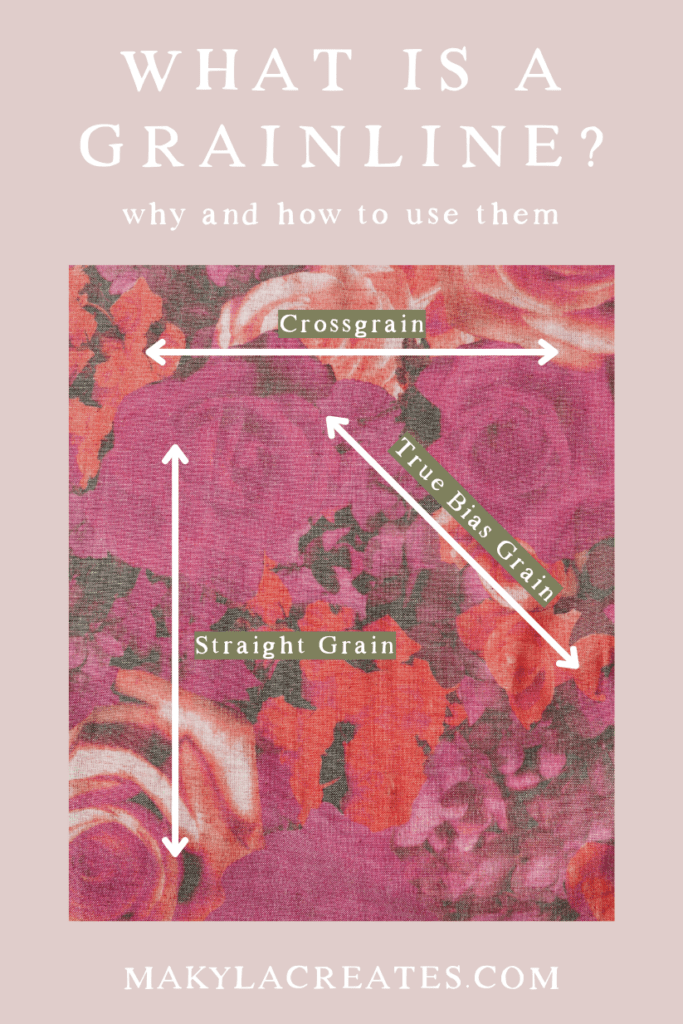
What is the Grainline of Fabric in Sewing?
The grainline helps guide you on where to place sewing patterns on woven fabrics. In sewing, grainline refers to the lengthwise yarns or straight grain of the fabric weave, also known as the warp threads. The lengthwise yarns or straight grain runs parallel to the fabric’s selvedge.
Check out my blog post on Types of Fabrics and Materials with Names and Pictures to learn more about fabric weaves and the warp and weft.
What is a Fabric Selvedge?
The selvedge is the sewing term for the uncut edges of a fabric roll. Each end of the fabric has a continuous edging or border that stops the material from falling to pieces. It can sometimes have holes through it from when it was woven together.
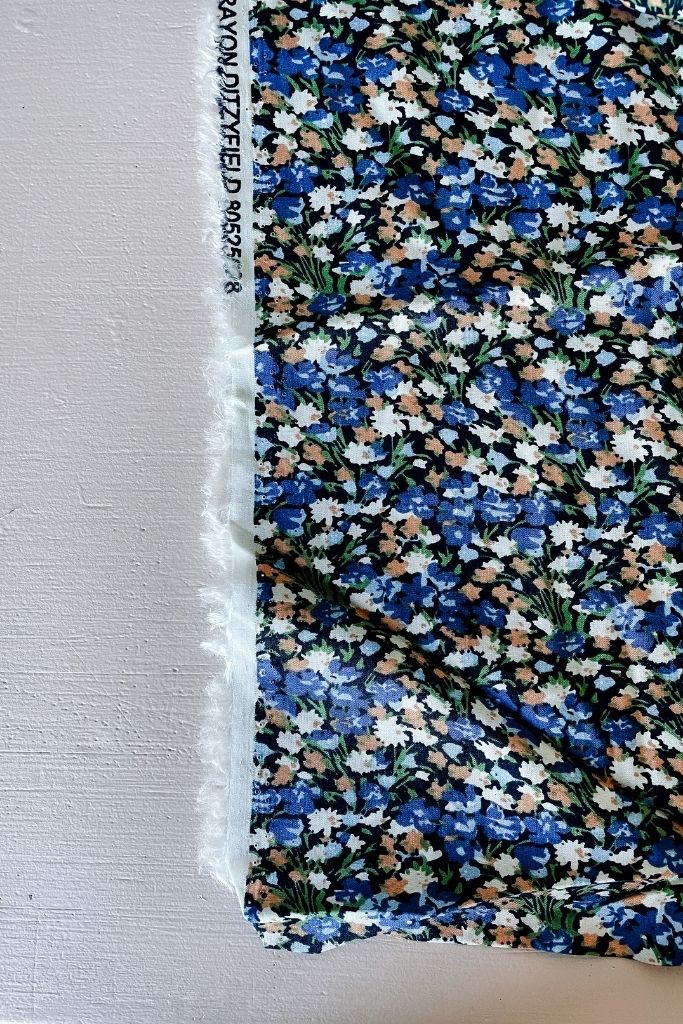
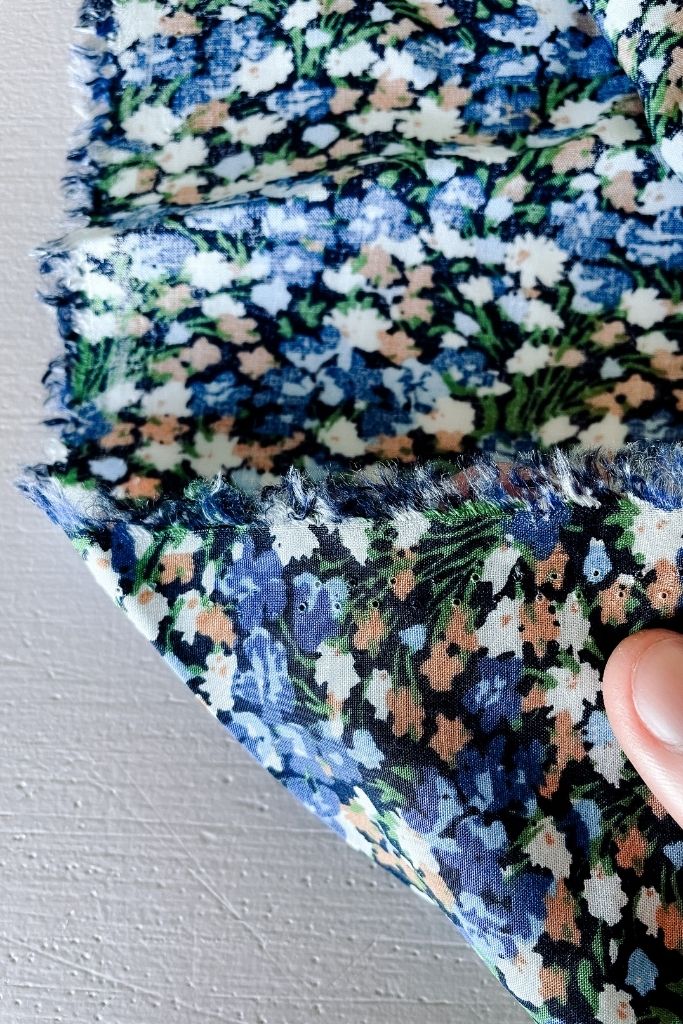
Different Types of Grainlines
Fabric will drape a certain way depending on how it’s cut. There are three standard terms used in sewing that relate to the grainline. These are the straight grain, cross grain, and bias grain.
1. Straight grain
The straight grain runs parallel to the fabric selvedge meaning the grainline runs up and down a garment. Since warp threads are often longer, continuous-length yarns, the straight grain is the strongest. As every sewing pattern will be laid out along the straight grain, this is the most important one to remember in dressmaking.
2. Cross grain
The cross grain runs perpendicular to the selvedge meaning the garment grainline will run around the body. A weft thread is a shorter length of yarn that crosses over the long warp thread as it is woven. This means the cross grain is not as strong as the straight grain. A garment may be cut on the cross grain depending on the fabric type and how the pattern designer wants the result to be.
3. Bias grain
A bias grain is when the fabric is cut on an angle. A true bias is cut at a 45-degree angle. When the material is cut on the bias, it allows the woven, warp and weft threads to stretch more than being cut on the straight or cross grain.
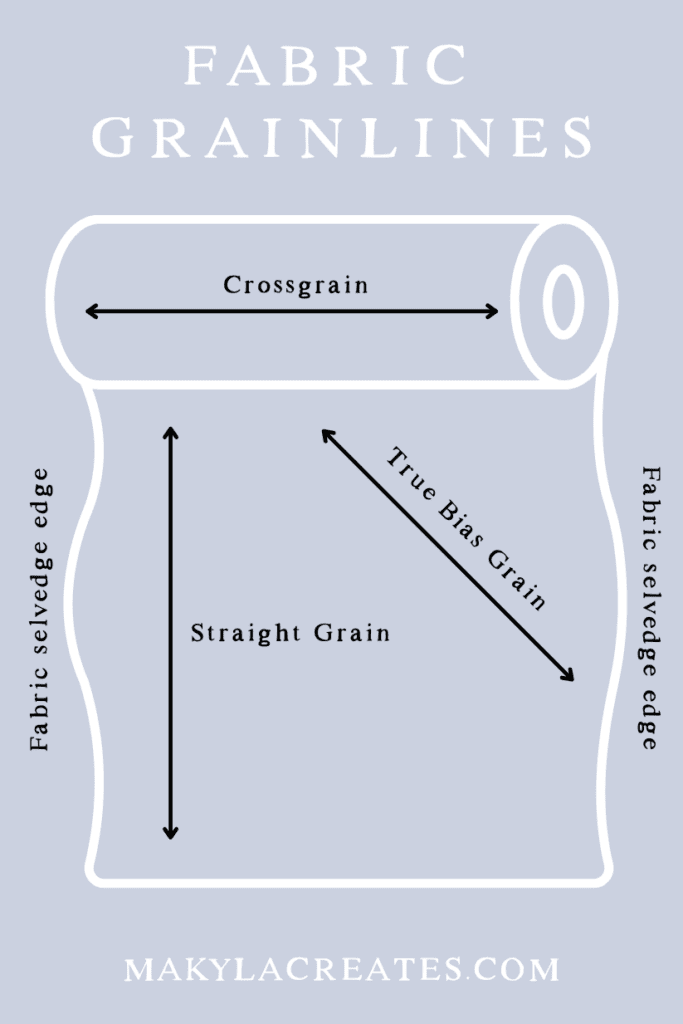
Why is there a Grainline on Sewing Patterns?
Sewing patterns have a grainline to show you which direction to cut them out on the fabric. This is determined by the pattern maker when they design the sewing pattern so you can recreate the same garment.
All sewing patterns will be positioned along the straight grain. How the grainline is placed on the sewing pattern determines if the finished garment will be cut on the straight grain, cross grain, or bias grain.
When pattern makers design a style, they decide how the pattern piece will sit on the fabric. For example, I created a bias skirt pattern. When the sewing pattern grainline is lined up with the straight grain of the material, it will be on a 45-degree angle. All you have to do is lay the pattern pieces on the grainline, and the skirt will be cut out correctly.
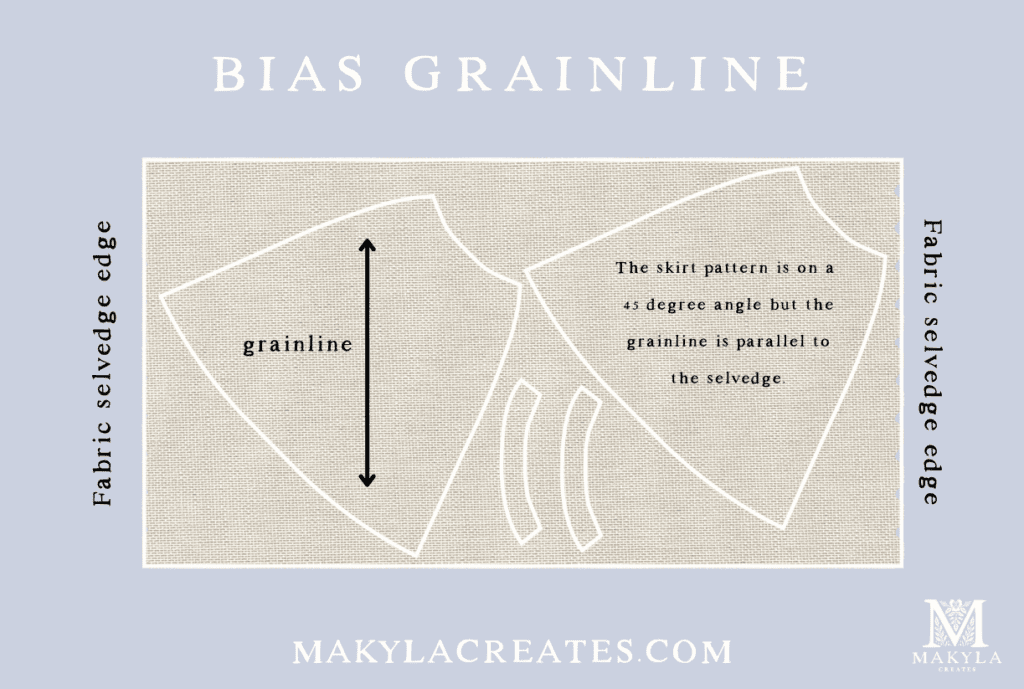
Sewing patterns include a lay plan which guides you on the best way to lay out your fabric and pattern pieces to reduce fabric wastage and ensure you buy enough fabric to fit all the pattern pieces. Follow these lay plans, so you don’t run out of room on your material.
Grainline Markings on Sewing Patterns
You will come across these two fabric grainline markings, the straight grainline or cut on the fold.
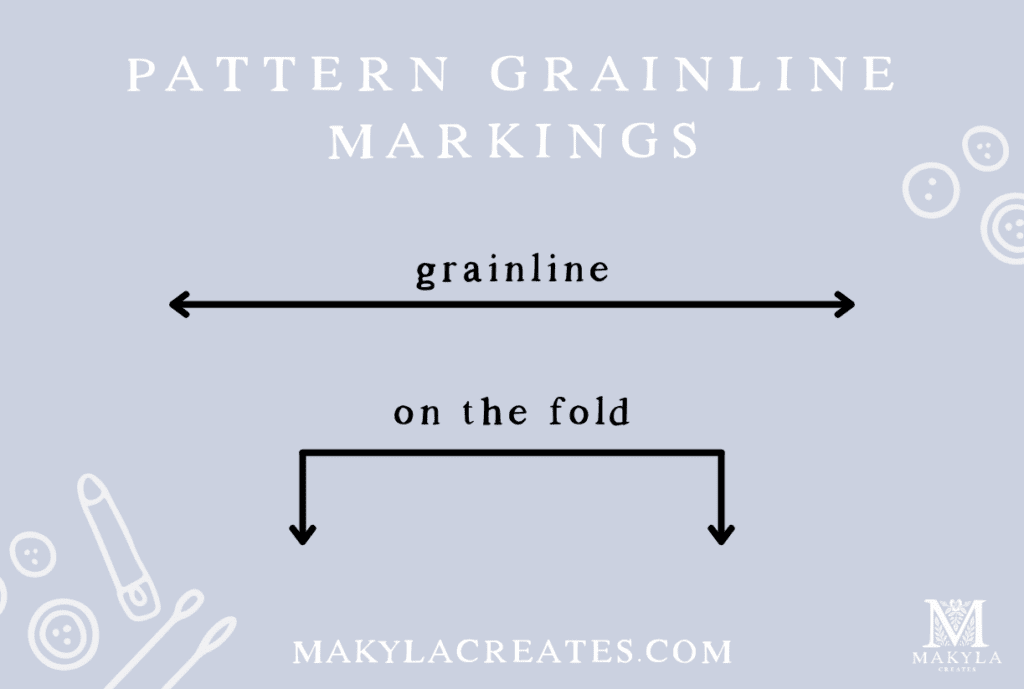
Open your sewing pattern and check each pattern piece for its grainline markings. Different pattern brands can have different styles of grainlines, but they will always be a straight line of some sort. Sometimes the grainline may be long or short, with end arrows or marked with ‘grainline’. It depends on the pattern designer.
You can also refer to the lay plan included in the pattern to double-check check your understanding of the grainline is correct.
If you see a cut on the fold, the marking is still a straight grainline to follow, but it means your fabric needs to be folded in half. The fold line will be on the straight grain when your fabric is folded in half with the selvedge’s touching. You can then place your sewing pattern along this folded edge to cut out.
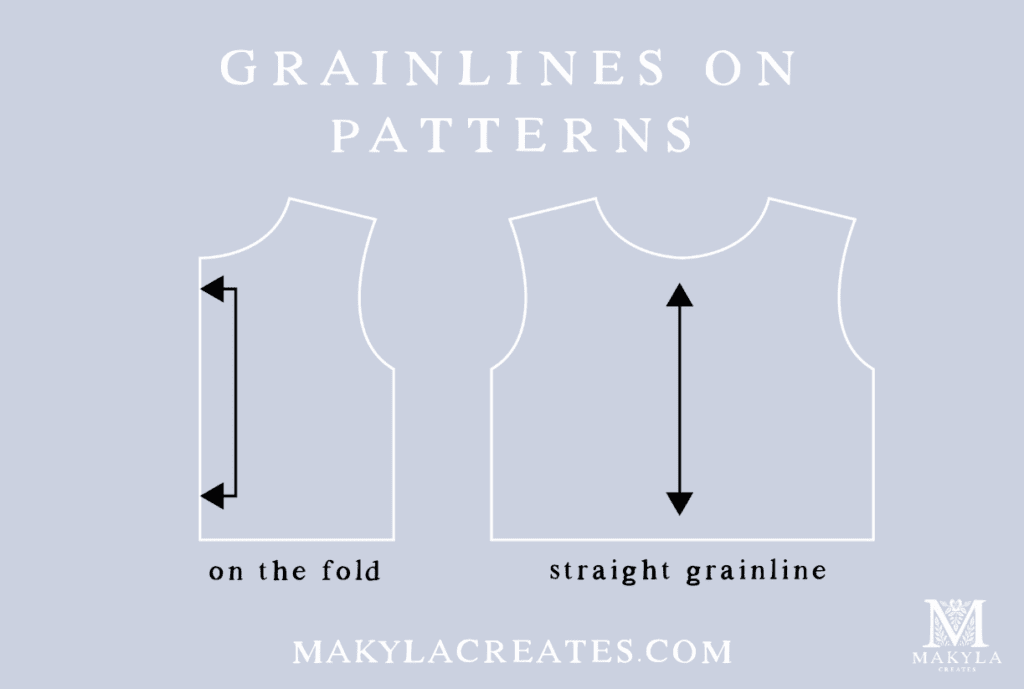
How to Accurately cut out your Sewing Patterns on the Grainline and why
The first thing I was taught when studying fashion was to lay out my fabric on a flat surface with a straight selvedge. A table edge can work great for this. I share some great tips in my How To Cut Fabric On The Bias post.
If you take the time to lay up your fabric correctly, the following steps will be a breeze.
- Use a measuring tape or ruler and measure from the edge of the selvedge to the grainline on the pattern piece. Jot this measurement down or in your head.
- Continue measuring down the grainline in two to four spots. Move the pattern piece until it’s the same distance from the selvedge.
- Do this for all the pattern pieces.
It’s essential to cut out your fabric on the correct grainline so the garment you are sewing will drape adequately. When cutting out your material, you may think it’s a minor detail, but it could make a big difference in the result. Pattern makers design patterns with the fabric and drape in mind so you can achieve the best results.
How To Find the Fabric Grainline
Sometimes the fabric grainline will be visible depending on the type of fabric. The fabric weave looks like a crisscross pattern. Here are two ways to find your fabric grainline.
1. Pull out a yarn
If there is no selvedge edge on your fabric, you can try pulling out a yarn across the cross grain. This will create a straight channel in the fabric weave, which you can use as a guide to get your fabric sitting straight.
2. Cut and tear
Another way to find the straight grain is to try cutting a small slit into the edge of the fabric and tearing it apart. This will only work on sturdier woven fabrics like cotton poplin or calico. Test a tiny bit of material first or stick to the pulling out a yarn method.
Grainlines for Stretch Fabrics
Stretch fabric doesn’t have a grainline because knit fabric types are looped, not woven together. Instead of having a grainline, the pattern is marked with a pattern direction, which is how the fabric stretches. Knit garments usually have stretch going around the body, so many designs are cut on what would be the cross grain in woven fabrics.